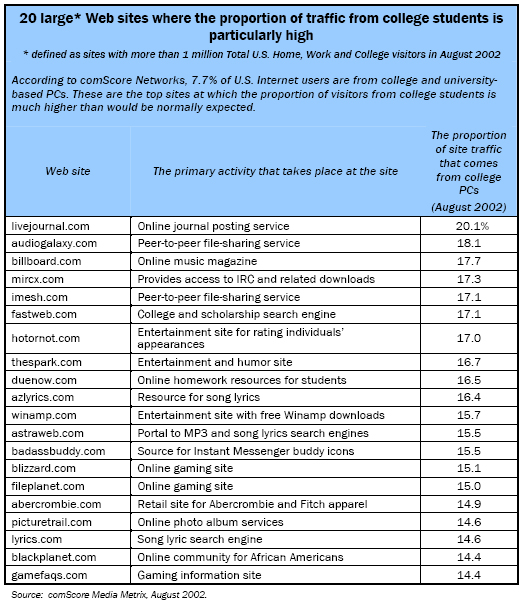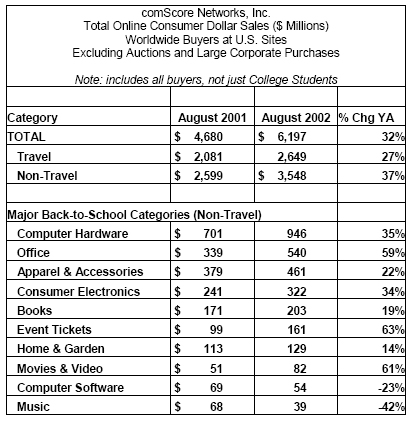College Students and the Web
PEW INTERNET & AMERICAN LIFE PROJECT DATA MEMO
FROM: Lee Rainie, Director of Pew Internet & American Life Project (202-557-3463, Lrainie@pewresearch.org/pewresearch-org/internet) and Max Kalehoff, Senior Manager comScore Networks (212-497-1745, press@comscore.com) and Dan Hess, Vice President comScore Networks (312-775-6477)
RE: College students and the Web
DATE: September 2002
The Pew Internet & American Life Project asked the well-respected Web tracking firm comScore Networks to provide data about several things:
- the kinds of Web sites that are particularly appealing to college students
- the kinds of Web sites were especially high proportions of college students shop
- the kinds of things college students buy online in relatively high proportions
- overall usage of the Web by college students broken down by the time of day
The accompanying tables and charts were built using the data provided by comScore.
Please note that site-specific data in these tables, do not refer to the most “popular” Web sites for college students. Rather, the data show the kinds of sites where unusually large proportions of college students make up the traffic.
Please attribute these data to “comScore Media Metrix,” which is a division of comScore Networks.
The table below shows large sites at which the percentage of college student Web traffic is much higher than would be “normally” expected, given the overall size of the online college audience compared to other users of the Internet. Somewhat expectedly, the university audience gravitates toward entertainment, society and community. Some highlights:
- Livejournal.com, an online personal journal service, had the highest composition of visitors from the university audience (20 percent).
- Audiogalaxy.com, where music fans can download the popular Audiogalaxy file-swapping software, had the second highest percentage of visitors from the college audience (18 percent).
- Other music-related sites and their percentage of visitors from the university audience included: Billboard.com with 18 percent; Azlyrics.com with 16 percent; and lyrics.com (15 percent).
- Duenow.com, an online homework resource, drew 17 percent of its visitors from the university audience. Fastweb.com, a scholarship and college-search service, also had 17 percent of its visitors from the university audience.

With lifetimes of buying power and potential brand loyalties ahead of them, college students are of great interest to many marketers – including those online. The next table shows e-commerce sites where the college audience is much higher than would be “normally” expected, given the overall size of the online college audience compared to other users of the Internet.
The university audience is often associated with its craving for music, movies and fashion. Not surprisingly, the top 20 shopping Web sites with the highest percentage of college visitors cater strongly to those three desires. Seven of the top 20 Web sites focus on apparel, four focus on movies and event tickets, and three are music related. Other popular sites focus on posters and artwork, video games and consumer electronics.
With 15 percent of its total U.S. visitors originating from the university audience, Abercrombie.com ranked highest e-commerce site according to its percentage of college visitors – as shown in the previous table. College students have always loved to photograph the good times and share those pictures with their friends. That helps explain why total visitors to Picturetrail.com, a photo-sharing Web site, were also from the university audience. Eastbay.com ranked third, with 14 percent of its U.S. visitors from the university audience.

The next table shows the spending on merchandise and services where college students’ share of the spending was relatively high, compared to other kinds of e-shoppers. comScore Networks reports that in 2001, $53.1 billion worth of merchandise and services were bought online at U.S. sites (excluding auctions and corporate purchases) by buyers from around the world. The vast majority (85%) of these purchases were made by U.S. buyers, of which college students accounted for 4.3%. Thus, this table shows the e-commerce categories where college-student spending was equal to or greater than their overall share of the e-commerce market.

Back-to-school Shopping
Looking at sales in the most recent month, several online merchandise categories had significant spending increases in August 2002 versus August 2001 – no doubt driven partly by students’ return to college. Event Ticket sales were $161 million dollars, up 63 percent versus one year ago; and Movies and Video sales were $82 million, up 61 percent. This comes as no surprise, given that event-ticket sites are among the most highly trafficked by the college audience, as mentioned above. Office Supplies and Stationery posted $540 million, up 59 percent; and Computer Hardware sales were $946 million, up 35 percent.

The material in the chart below demonstrates to a modest degree that some things about college life may never change. Students are still night owls – at least compared to other people. The chart shows that higher proportions of college students (labeled here as “school” users) are online between midnight and 4 a.m. than other Internet users.

The raw data are here:





